It was a few years ago that I blogged about the death of the medical conference. I had been to a fairly hum drum rural medicine conference and felt significantly underwhelmed with both the quality of presenters, the educational programme and the lack of vision for the future. Read about the experience here.
Since then I’ve only bothered to attend the smacc conference series…and it’s hard not to make the inevitable comparison between smacc and the other medical conferences. The smacc model of short, engaging speakers and a flat hierarchy (speakers and attendees are drawn from anyone involved in critical care (students, nurses, doctors, paramedics) and from many different tribes (prehospital, rural GP, emergency, anaesthesia, ICU, social work etc) – all united by passion for keeping ahead of the latest developments in care for the critical patient. Tellingly the first release tickets for smaccDUB were sold out within a few hours of registration opening – a first for any medical conference I reckon!
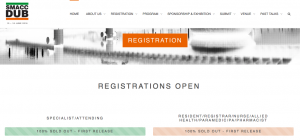
In 2015 I dipped my toes back into the world of other medical conferences – sure, there was smaccCHICAGO at which I infamously spoke…but also chance to both give talks and run workshops at GP15, PAIC2015 and RMA15…
So – four conferences in as many months. I reckon this has given some insight into what works, and what doesn’t. So here are my suggestions. Read along with the previous blog post on the need for presentation skills for medical presenters
(i) pick a bonza venue
I am not a fan of those ‘conferences in exotic locations‘ (it’d be nice, but the reality is that this can be exclusive). Better that the conference is held in a dedicated facility with excellent transport options and nearby accommodation and dining. All of the major cities have conference centres – use them!
More importantly, make sure the venue is appropriate and doesn’t involve too much time walking. GP15 was noticeable for having the sessions held some distance from the exhibition hall, requiring a mass move of people between floors and buildings. Not cool!
(ii) make the programme available well in advance and make it easy to navigate
People are paying a LOT of money to attend and won’t commit unless they know what they are up for. It’s a nightmare to organise a conference…but in my mind there’s no excuse not to have confirmed speakers and sessions sorted 6 months or more prior. Having speakers confirmed and grouped into themed sessions punctuated by keynotes and plenaries makes sense. Certainly do not launch registration until speakers are confirmed and a session timetable is available – most of us want to know what we are stumping up for before committing the moolah!
Many conferences seem to use apps nowadays. I am a bit of a tech geek and love apps…but to be honest I’ve been significantly underwhelmed with all the conference apps used this year. It may seem a god idea to have links to social media, networking contacts, QR code readers and the programme available online – but many are poorly designed and hard to navigate.
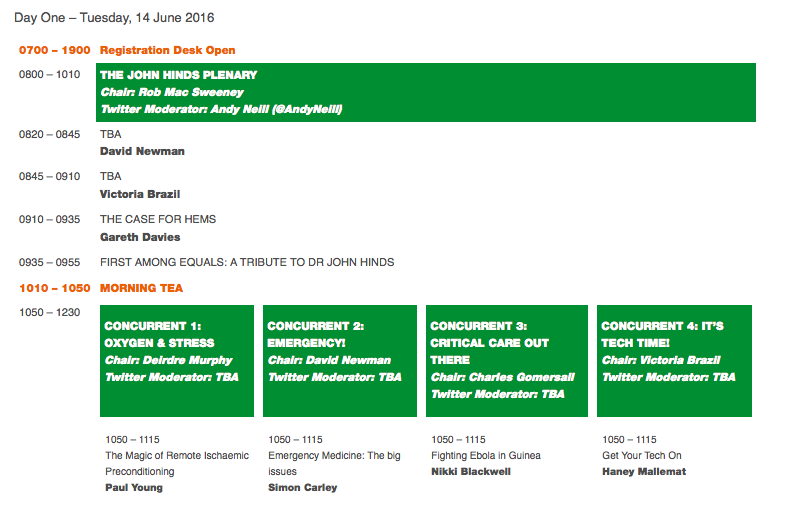
Give me a simple pamphlet that is easy to navigate. Make sure the format is like a standard timetable, allowing people to easily see what sessions are on when and where, for each day. Again smacc does this well, as did PAIC2015. GP15 was so-so and RMA15 was a spectacular fail in this regard.
(iii) run good pre-conference or post-conference workshops
Everyone likes to tack on some quality CPD. Most conferences I went to ran workshops before or after the conference main. GP15 was perplexing in that whilst there were some workshops prior, there were also ‘active learning modules’ and workshops of several hours duration plonked right in the middle of the conference, meaning that those registered for an ALM couldn’t attend the conference proper. Keep the learning modules separate to the conference sessions where possible.
Most of us enjoy hands on workshops – but preferably delivered by clinicians drawn from own craft group. CPR skills are mandated for all GPs and were offered at GP15 – but I reckon it would be really cool to have GPs teaching GPs to do this, rather than outsourcing to a first aid provider. Ditto sessions on sonography, retrieval, opiate dependence etc etc – better to be delivered by credible clinicians from the craft group, rater than partialists (specialists) – they may be experts in their specialty, but they are NOT experts in the arena in which audience practices.
Whilst it’s easy to establish workshops on the obvious clinical topics, I have greatly enjoyed workshops on other areas relevant to my practice – these might include clinician self-care (avoidance of burnout), creative writing, presentation skills and so on. Workshops on social media and FOAMed are becoming increasingly common – as are those centred on heutagogy and metacognition for adult learning.
Resilience is also a hot topic currently – whether developing cognitive resilience for clinicians in high stakes arenas (prehospital, emergency care) or resilience for a professional lifetime of grind (saying no to inappropriate requests, avoiding burnout etc). Tackling topics which are common memes but often ignored in traditional education can offer a more nuanced approach to achieving mastery in the discipline.
Sim is creeping into medical education more and more – it’s possible to deliver high quality sim sessions across a variety of clinical arenas for large groups…and also to offer workshops in how to run sim sessions and debrief properly. I’ll mention events such as SonoWars, SimWars & FernoSim a little later….
(iv) have a good mix of plenaries, breakouts, workshops and concurrents
It’s easiest to frontload each day with a keynote or two – but keep them short, no more than 30 minutes. Then break into concurrent sessions for rest of morning. Rinse and repeat in afternoon, although may wish to close each day with another keynote or plenary session. I think of it as :
<opening session keynote/plenary – everyone present>
<concurrents – break into groups>
<lunch>
<concurrents – break into groups>
<everyone present for forum/keynote session>
Inviting expert panel discussion and audience participation works a treat for contentious topics and increase engagement. There are some REALLY interesting software packages out there to make audience participation easier eg: live polling – I’ve been playing with GLISSER and CROWD MICS to allow audience polls during a presentation or use of own smartphone as audience mic, respectively.
(v) have a varied academic programme
I loved the smacc2013 idea of submitting abstracts as a ‘pecha kucha’ competition in the months prior…this increased the hype and engagement of participants, and allowed the BEST talks to be selected to be delivered as a 15 min presentation…whilst also building up a resource of rich PK talks for use as an asynchronous web resource. For those of you who haven’t seen the PK format, it’s very simple – 20 slides, each of 20 seconds duration – or thereabouts – total talk time is 6 mins 40 secs (400 seconds) and ensures a short, punchy delivery for maximum impact.
So – invite abstracts early, and filter the best for presentation. I was perplexed at GP15 and RMA15 as the academic programme seemed to mix & match talks inconsistently…where possible ensure themed sessions are grouped.
(vi) insist on short, punchy presentations and ensure conference speakers prepare properly
It’s no secret that I am not a fan of ‘death by powerpoint’. I was in a fit of rage to hear experienced professors of emedicine apologise for ‘this is a busy slide’ or ‘some of you may not be able to see this at the back’ – saying this implies that you really don’t care about the audience
So, some rules
- ensure all presentations are kept short (20 mins, plus 5-10 mins questions)
- get presenters to submit slides 1 month prior to the conference. Exert editorial control over slides that are busy
- ensure presenters use the appropriate slide dimensions (4:3 or 16:9)
- make sure the presenters are briefed to KEEP TO TIME and TALK LIKE TED
- follow the rules on creating a killer slide set – large good quality pictures, few words, zero bulletpoints
- remember the 10-20-30 rule : 10 slides, over 20 minutes with minimum 30 point font
Many speakers get hung up on trying to deliver their thesis or research paper as a powerpoint slideset. Forget that. Speakers are there to educate and entertain. The audience will remember only three things (at most) from your presentation. What REALLY matters is to tell a story and to engage the audience in order to make them care! My mate Gracie Leo talks about presentations that have PURPOSE, PASSION and are PRACTICED
There’s often concern about story-telling vs hard-hitting science for presentation format and delivery. I think a blend can be achieved easily enough – but you HAVE to engage in order to educate. If you accept that the purpose of speaking at a conference is to impart information about your area of expertise, then surely it’s important to look at effective methods of delivering that knowledge? A powerpoint version of your acadeic paper won’t cut it!
Have a read of this post from Simon Carley of StEmlyns http://stemlynsblog.org/medutainment-and-emergency-medicine-part-2-why-are-we-talking-about-it/
If in any doubt, read the advice in this blogpost on presenting at medical conferences. Please!
(vii) Encourage dissemination of conference content as FOAMed
In the spirit of FOAMed, encourage speakers to make resources available for the audience – this can be in the form of ‘flipped classroom’ content for workshops, and as show notes for short talks (I usually include a QR code or link to a DropBox link containing all relevant references, copy of slides and additional materials such as videos or links at the beginning and end of my talks).
Many people are unaware that both Powerpoint and Keynote allow speakers to quickly and easily generate a narrated slideshow video of their presentation. This is GREAT as it means you can make your talk available for people to watch again and again – and savvy speakers will use social media to allow the ‘reach’ of their talk to be vastly increased by releasing the narrated slideshow video at same time as they deliver their talk – I’ve given talks to a room of 50 people…whilst over 500 have downloaded the talk in the same hour.
Hot tip – get all speakers to agree to make their slideset available as FOAMed.
Encourage speakers to create a video file of their talk by recording a narrated slideshow in Powerpoint/Keynote, saving this as a video file and then uploading to Vimeo, YouTube or DropBox for sharing
Sure, conference organisers can video talks as they are delivered and upload them, but this is expensive, labour intensive and files can be large to download. Such videos are often also hidden behind paywalls or secure logins. Beter to make them available as FOAMed. Encouraging speakers to make their talks and their content available as FOAMed both before, during and after the conference accelerates the interaction and leads to greater participation….which is what a good conference is all about
(viii) Make sure the tech stuff is rock solid
Needless to say every conference nowadays needs blisteringly quick wireless internet access and the login details should be available to all attendees.
Many conferences now have their own hashtag – this should be used pre-conference to publicise and preferably be short and easily memorable (#smaccDUB, #PAIC2016 etc). Along with a Twitter hashtag comes the need for a twitter account and the possibility of twitter moderation – thus a keynote delivered at the conference can generate questions and comments from a worldwide audience. Having a twitter moderator can be useful to sift and sort questions and put to the speaker in the alloted time.
Symplur is the de facto medical conference analytics site for social media impact – check out their metrics (but make sure you register the conference hashtag with Symplur to generate the data – it’s free)
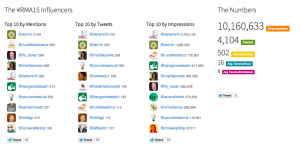
Many of us use Macs over PCs. Insisting that speakers only use Powerpoint pre-2007 is ridiculous…a conference should be able to deal with most presentation formats and have options to hotswap between Mac/PC, as well as afford sound and video via HDMI, VGA and other connectors.
I think it’s high time we all abandoned the lectern or podium and allowed speakers to roam the stage or amongst the audience. A headset (or lapel) mike can achieve this and allows a much more relaxed presentation style. Insist on this.
(ix) intermix the conference programme with some fun
I am not talking about clowns and jugglers (although this could be fun). Nor the Gotterdamerung of marching bands and firedancers in the opening ceremony. But one of the joys of smacc has been the introduction of some novel yet educationally-sound fun. And to entertain is to educate.
I’ve mentioned the PK talks as a vehicle to generate abstracts and select the best for presentation, whilst also building up a knowledge base for free dissemination. That’s easily reproducible. But having tongue-in-cheek debates or even cage fights between opposing views can be a stimulating way to educate and entertain.
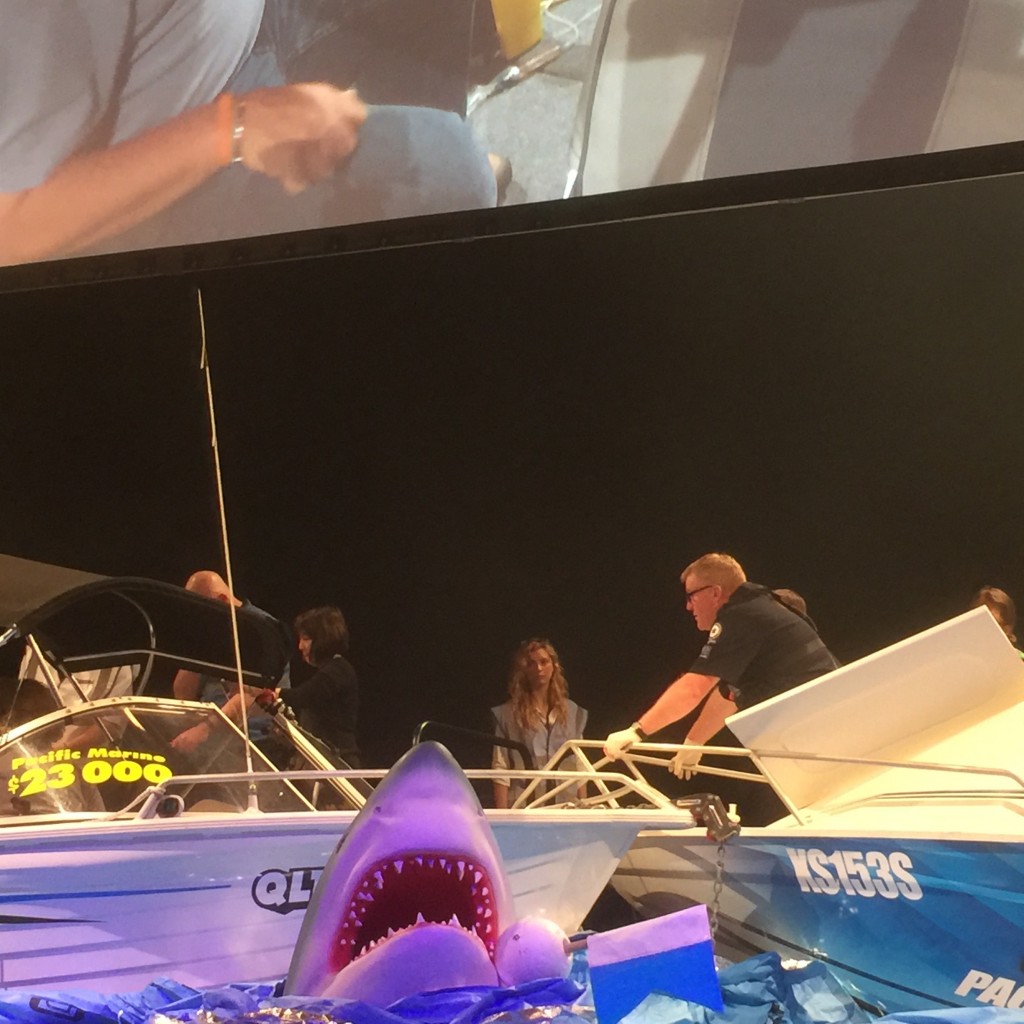
Some of the BEST medical education I have ever seen has come form the SonoWars and SimWars series at smacc, and the FernoSim at PAIC2015. These are big ticket items – competing teams performing in front of a large audience on the main stage, either undertaking various challenges (performing an eFAST on a mechanical bull in SonoWars) or engaging in gnarly sim and hot debrief (SimWars).
Teams for around the world competed in FernoSIM – this year’s event in Adelaide involved a traumatic amputation from sharkbite, a speak-gun injury, decompression illness and crowd control…all onboard two small dive vessels off the coast of Australia…one of which caught on fire! Doing this well requires skillful compere skills and a rapid changeover of teams/equipment to maintain audience enthusiasm. Debriefing in front of a large crowd also has to be done sensitively – the Pendleton Rules shit sandwich won’t wash!
(x) have a great social programme
Some people like a formal black tie/frock Gala dinner – others like a less formal drinks n nibbles. Social media allows attendees to attend not only the planned conference events, but also to generate their own – the #EMSWolfPack movement kicked off in Chicago and saw many prehospital paramedics crowdsource ther own social events in parallel with the other fine events. RMA15 and smaccUS both had fun runs and other social events – smaccYAK (a kayak tour on nearby rivers licked off in Chicago and we will be doing the same on the River Liffey in Dublin June 2016)
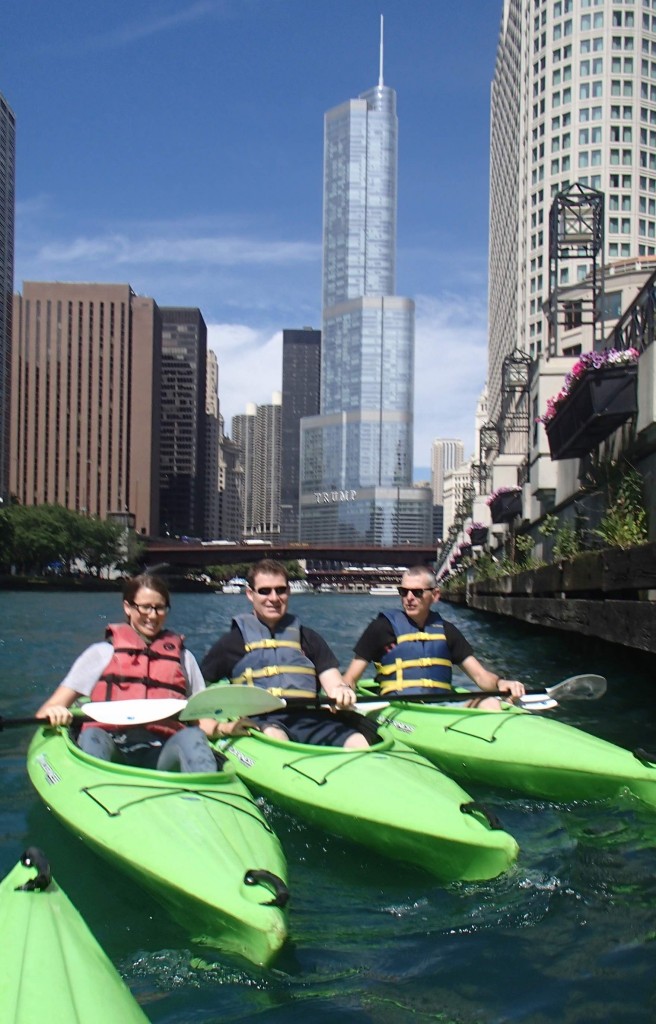
Kirsten Kingma – Paramedic & Medical Student, South Africa
Mark Wilson – Neurosurgeon & HEMS doc, UK
Colin Dibble – Emergency Physician, NSW Oz
Similarly sit down gala dinners are fine – but don’t exactly encourage interaction and intermingling. Some events cater well with small food tents offering nibbles and drinks, with a live band playing and opportunities for attendees to dance, mingle, mosh or chillax, depending on space and available seating. Much better than 12 strangers sitting at a table!
What else? We’ve had FOAMeoke (karenoke amongst the FOAMed mob), bar meets, sight-seeing (inc visits to concomitant U2 concerts, cocktails atop Sears tower, baseball games)…but not confined to smacc – the rural docs conferences do this sort of stuff really well with parallel medical students programme, creche for kids, family activities and so on.
Finally – remember the goal of the conference – to inspire, to educate – changing the format from the usual tired old format of lectern-seats-hour-long powerpoints will encourage interaction and true innovation. Try it.
Interested in others thoughts on what makes a good conference….
Hi Tim,
I like this. Not just a guide but a thoughtful review and I agree with everything you say. Most importantly as a speaker/organiser we have to recognise that delegates have given time and cash to attend. We owe them as good an experience as we can muster.
Great work and hope to see you soon.
vb
S
Important topic and Fantastic review of all the important elements of a conference. I especially like the comments about variety of experiences for the learner. While I am sold on the TED format for inspiring the audience about new ideas, I think this short format often ends up with thin content that might SOUND great but doesn’t really inform the audience. If good presentation skills are used, I believe that a 40 minute talk can be both inspiring AND informing. I find that my attention is held and I actually remember the content more in a 40 minute talk that goes into a bit more depth and explores the topic a bit deeper. Keep up the great work on your blog!
Hey Tim
Great article
We’re still learning as we go at DevelopingEM but I think we’ve checked a few of those boxes
And we sponsor local colleagues (200 so far) with no industry support
Next year we’re in Colombo, Sri Lanka (Dec 3-9, 2016)
We hope to have the website updated in December so stay posted
http://www.developingem.com
Love the blog- keep up the great work
Be good
Mark Newcombe
I think one of the most useful formats that SMACC introduced was panel discussions.
I often found it frustrating at conferences when a series of speakers were asked to speak on a topic but didn’t stay to the end. It is particularly useful for a final Q&A session to tie all the thread togethers and to resolve contradictory statements or different points of view. These session often gave a more nuanced understanding than just a straight presentation could provide.